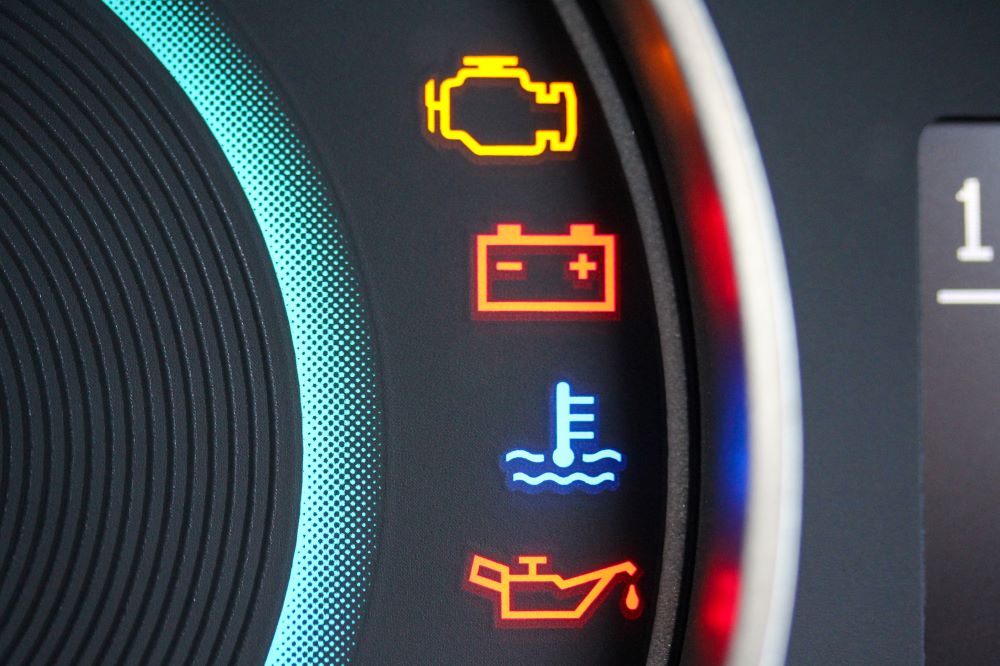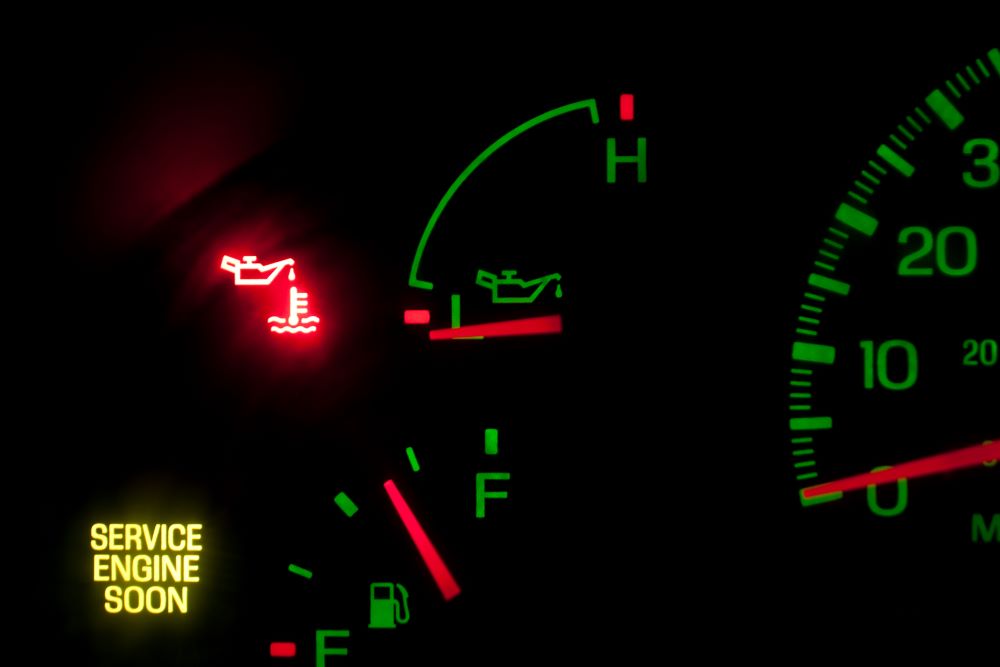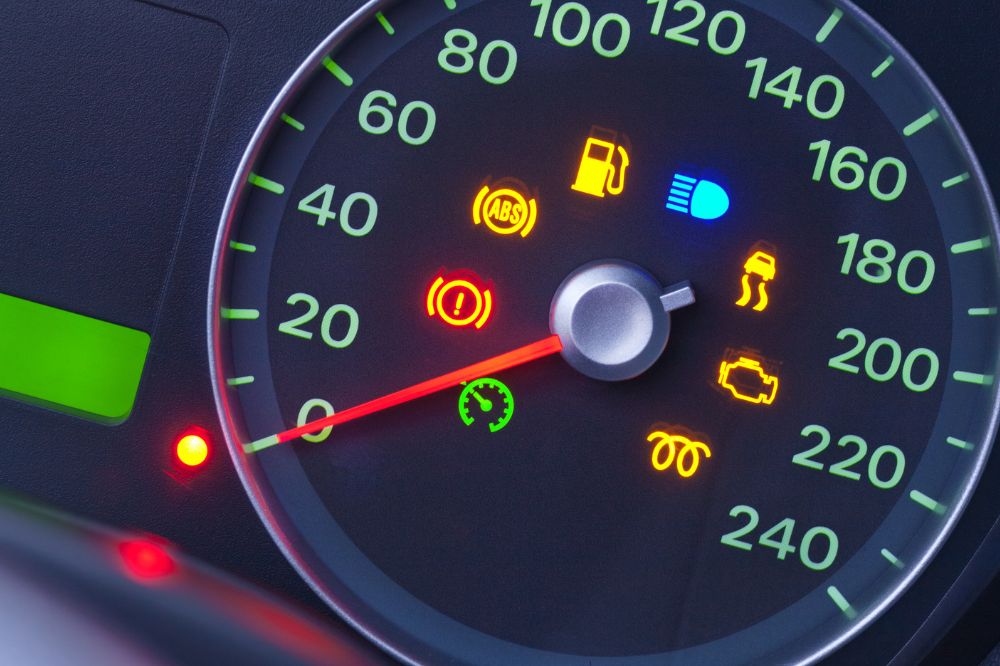
Interpreting semi truck warning lights is essential to keeping your truck in top condition and ensuring road safety. These lights are your vehicle’s way of signaling either a potential issue that requires immediate attention to prevent a malfunction or a fatal accident, or a reminder for routine maintenance.
The problem is that semi trucks have many warning lights, and new ones are added as technology improves. This can make it hard to know what each warning light means and what to do when they come on.
We’ve created a quick guide to help you understand common dashboard warning lights, their meanings, and the actions required. By following this guide, you can maintain your truck’s safety and reliability.
Common Dashboard Warning Lights
Even though the symbols and location of warning lights differ based on a truck’s age or model, some lights are present in all semi-trucks. These conventional warning lights include:
Check Engine Light
The check engine light is one of the most common and often misunderstood dashboard warnings. It can appear in different colors and signal a range of engine issues.
Shaped like an engine, the engine warning light may illuminate in orange, yellow, amber, or red. It can flash or stay on, indicating anything from minor issues, like a loose gas cap, to more serious problems, such as a faulty catalytic converter.
When it lights up, it’s best to visit a qualified mechanic for a diagnostic check and repairs to prevent further damage.
Fuel Gauge Warning
The fuel gauge warning light appears as an image of a fuel pump beside your fuel gauge. It lights up to let you know you’re running out of fuel. In some trucks, this light comes with an alarm to alert you to take action as soon as possible.
Fill your fuel tank soon to avoid running on low fuel. Continuing to drive your semi-truck on low fuel might force your engine to pick up the sediment and sludge at the bottom of your fuel tank, potentially causing preventable damage.

Engine Oil Pressure Light
In most vehicles, the engine oil pressure light resembles an old-fashioned oil can or a genie lamp, but some dashboards display the word OIL. It will light up red to inform you that your engine oil levels are too low.
When this light appears, pull over to a safe location. Often, topping off the oil will resolve the issue. However, if the light stays on, visit a certified mechanic for a professional diagnosis. It could indicate an oil leak, incorrect oil viscosity, or the need for an oil change.
Coolant Level Indicator
The coolant level indicator resembles a box or thermometer and has wavy lines representing a liquid. It comes on to signal that your engine’s coolant level is too low. This requires immediate action to prevent overheating, which can cause permanent engine damage.
Anti Lock Brake System (ABS) Light
Semi-trucks and other heavy commercial vehicles use sophisticated braking systems, including air brakes and an anti-lock braking system (ABS). The braking system has a warning light to notify you of any problem that may prevent it from working effectively. Such issues include worn-out brake pads, low brake fluid, or more severe problems.
If your ABS light flashes, address the issue immediately to avoid putting yourself and other road users at risk. Brake problems are one of the top causes of truck accidents.
Tire Pressure Warning Light
Modern trucks have systems to monitor tire pressure. When the pressure in one or more of your tires drops below the recommended minimum, the tire pressure monitoring systems (TPMS) warning lights will alert you.
Ensure you check your tire’s pressure at your earliest convenience when you notice this light. Underinflated tires are likely to fail, leading to fatal crashes. They can also increase your fuel costs.

Understanding Warning Light Colors
Warning lights have different colors. Understanding what these colors mean can give you a hint of how urgent the message they’re trying to send is. You’ll know what action to take and how fast you need to act to keep your vehicle healthy and safe. The most well-known colors include:
Red Lights
Red lights signal severe problems that require immediate attention. These include issues that can lead to equipment failure if left unattended, such as low oil pressure, engine overheating, and brake system failure. Equipment failure is a proven cause of semi-truck driver accidents.
Yellow/Amber Lights
Yellow or amber lights indicate issues that require your attention, but they may not be as pressing as the issues signaled by red lights. These might include issues with your truck’s emissions control system, low fuel, or minor engine problems.
Although they’re not immediate emergencies, don’t ignore the problems highlighted by these lights. Ensure you get your trusted mechanic to check and repair them as soon as possible to avoid engine shutdowns or potential vehicle breakdowns, which might lead to more costly repairs.
Green/Blue Lights
Green or blue lights are informational or confirmatory. They indicate the condition or status of different systems in your semi-truck. While they represent non-critical notifications, paying attention to them is still essential. They’ll remind you of specific actions to ensure you’re driving safely and your vehicle remains in good condition.
Green lights, in particular, can let you know if your lights are engaged, turn signals are on, or other systems are active. On the other hand, blue lights will tell you if your high-beam headlights are on or if your coolant temperature is at a normal level.
Responding to Warning Lights
There are three main ways to respond effectively to warning lights: pulling over, troubleshooting, and consulting your mechanic.
- Pull Over: If your check engine light flashes or turns red, pull over, turn off the engine, and contact your mechanic. This typically signals a serious engine issue that could compromise safety.
- Troubleshooting: Consult your manual to handle common minor issues. It often explains warning lights and may include model-specific instructions.
- Consult a Mechanic: Red, yellow, or amber lights should be checked by a certified mechanic for an accurate diagnosis and proper repair advice.
Final Thoughts
Warning lights are your truck’s way of saying things are not fine. Listening and addressing them effectively ensures proper vehicle maintenance and maximum safety.
Remember, if a warning light comes on and you realize there’s an issue, the earlier you visit a qualified mechanic for professional diagnostics and repair, the better. This is because car problems worsen with time. Taking too long to fix issues will lead to costly repairs that might dent your finances.
If you ever need help financing your semi-truck repairs, call or e-mail us. We offer affordable semi-truck repair loans to help you minimize downtime and get the most out of your trucking venture.


